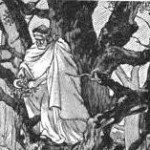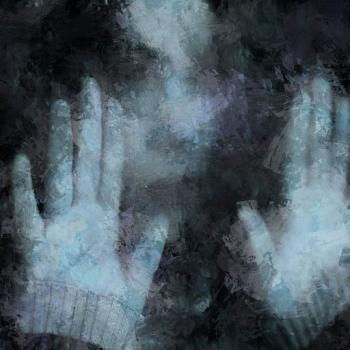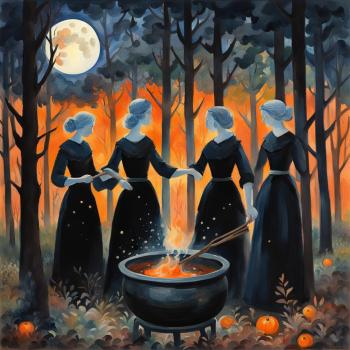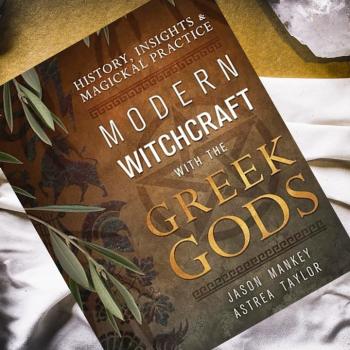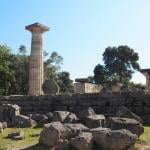“But ever since we stopped burning incense to the Queen of Heaven and pouring out drink offerings to her, we have had nothing and have been perishing by sword and famine.” (Jeremiah 44:18)
Disclaimer #1: I write this column from the perspective of a folk practitioner, not a religious scholar. Please forgive any errors or misrepresentations.
Disclaimer #2: I am a Jew, and a dedicant of the Morrigan. I need to write about Gaza. But if I’m going to say something about Gaza, I need to say it right, so I’m taking my time with that post. Sadly, I think it’ll still be timely in a couple of weeks (or months, or years, or decades).
Growing up, I always thought that the expulsion of the Goddess from organized religion among the ancient Israelites was done in one fell swoop. My ancestors took the land of Canaan, established the Temple of Yahweh, and presto! No more Goddess–except among the common folk, who needed to be continually corrected and controlled.
I later learned, though, that the process was much more gradual, full of negotiations and reversals. Each Jewish king had a different relationship to Asherah, the mother goddess of the Canaanites and Jews. One king would take all her images out of the temple, smash her altars and forbid her worship; the next king would haul in new ones and give the all-clear. Back and forth it went like this, for generations: out she went, and then back in, exiled and then pardoned. It breaks my heart whenever I hear modern Jews talk about the end of Israelite paganism with relief and back-patting, as if the worship of a beloved goddess were akin to alcoholism or online poker. Take, for example, this passage from Ellen Frankel’s The Five Books of Miriam, a book of feminist Jewish commentary on the Torah:
“Fighting idolatry proved to be a long, difficult battle….It took many centuries before we struggled free of paganism. Periodically, the people backslid and had to be wooed back to YHVH. We prophets, priests, and kings often had to resort to harsh threats and actions to expel idolatry from Israel’s midst.”
The passage is deliberately provocative (it’s written from the point of view of Huldah the prophetess), and Frankel later attempts to provide a counterpoint. But even that doesn’t stray very far from patriarchy:
“[Asherah] was obviously a beloved figure to the Israelite people, and her influence can be felt even today, in feminism’s intellectual flirtation with the goddess.”
That second line, by the way, is written from the point of view of “Lilith the Rebel.” How rebellious!
“Struggled to break free.” “Intellectual flirtation.” Asherah wasn’t a vice. She wasn’t a sin. She was our goddess. She was our goddess.
I cannot believe we did that to her. To ourselves.
So, who exactly was Asherah? Unfortunately, we don’t know quite as much about her as we do about other Near Eastern goddesses. She was the mother of the Canaanite pantheon. She was considered the wife of El or Baal, then Yahweh. She may have been referred to as the Queen of Heaven, although that title more likely went to Anath. Her full title was Lady Asherah of the Sea, and she was a goddess of motherhood, fertility, and childbirth. Her public altars consisted of wooden poles and figures that were erected next to images of her husband. Households used small clay figurines to represent her–and, tellingly, archaeologists haven’t found corresponding male figurines.
Now, the Goddess’s presence in Judaism didn’t end in the Temple era. The Shekhinah, originally the Talmudic term for “God’s dwelling place” and visually represented by pillars of smoke and fire, came into her own with the rise of Kabbalah and has morphed over the centuries into a mother goddess very similar to Asherah. Many Jews, including myself, see her not just as the feminine side of God, but God Herself: Big Mama, the Creatrix, the Star Goddess. I like to think that the Shekhinah is what Asherah might have become, had she had the benefit of millennia’s worth of theology and practice. Perhaps she’s even Asherah herself, patiently slipping into a new guise–like the savvy mother of an angry toddler, waiting for the tantrum to subside before coming in to comfort.
Or maybe not. In Israel, a small but growing Pagan community is honoring ancient Semitic deities. Here in the States, the Kohenet Institute published a Jewish prayer book that contains a prayer to Asherah:
Ashera, Queen and mother of the land of my mothers, and my mothers’ mothers. It is to you that we still offer honey cakes in gratitude for your sweetness….
-E. Sheva Melmed
Perhaps Asherah doesn’t need a new guise. Perhaps she and the Shekhinah are happily coexisting, each an aspect of the other, yet distinct.
Tarot is a big part of my practice, and I often use the cards as an oracle when talking to deities. The other night, I invited Asherah to my altar and asked if there was anything she wanted me to write in this column. I drew Strength, the Hanged Man, and the Knight of Swords, and here’s what she told me:
I gave my people strength. I gave them strength on the hills and under the trees, in the grasses and by the sea. When those in power took their strength away, I restored it. But my children froze themselves in time when they finally banished me, and are now unable to move forward. The prophets came so close to understanding justice–they came so close!–but, in the end, they sabotaged their own ideals.
Then I asked her what she wanted from modern-day Pagans, Jewish or otherwise. I drew the High Priestess.
I’ll leave that one for you to interpret.
May you feel Big Mama’s presence always. May your your heart be her dwelling place.
Jewish Witch is published on alternate Tuesdays. Subscribe via RSS or e-mail!




